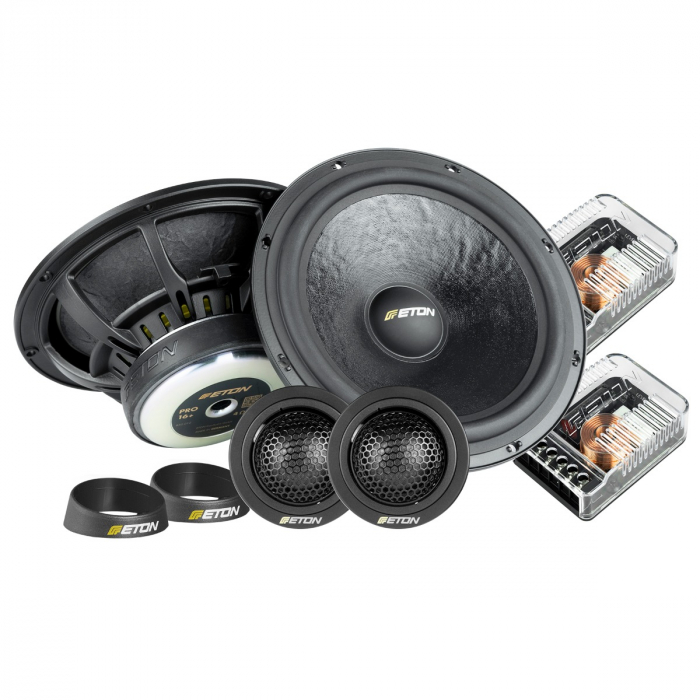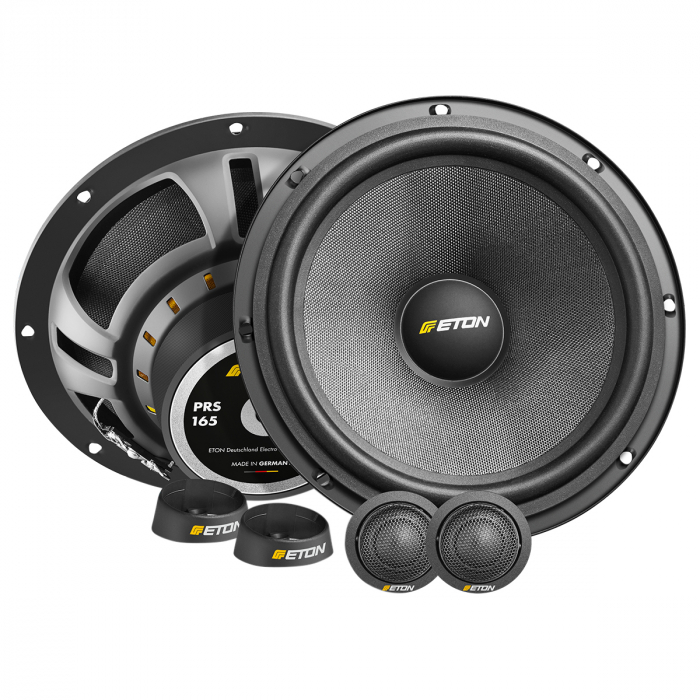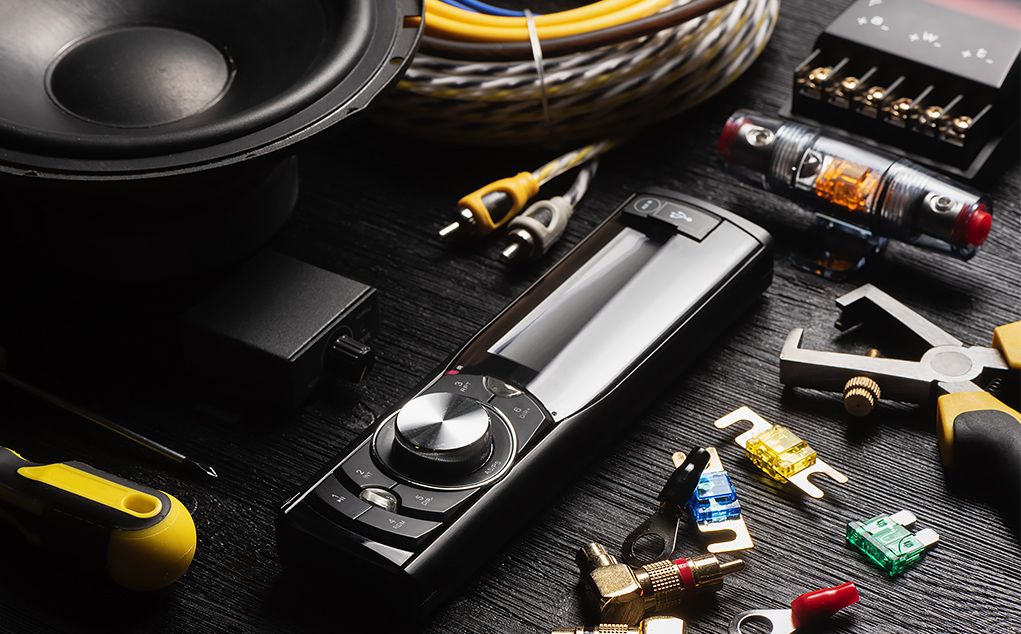Gone are the days when the pinnacle of car audio was an AM/FM radio with a cassette player. Our beginner car audio guide helps you navigate from basic radio units to advanced sound systems, enhancing your driving experience like never before.
But why does good car audio matter? For many, it elevates the driving experience. Music, podcasts, or even an audiobook can make long drives enjoyable and daily commutes bearable. A crisp, clear, and immersive sound ensures that you savor every note and understand every word.
Now, making your way into your first car audio install might seem daunting, but that's where this guide comes in. Consider this an ever-evolving handbook. As new information and technologies emerge, we'll ensure this guide reflects the latest in the car audio realm.
Jump to Section
Basic Terminology
Before we delve deeper into this car sound system guide, it's essential we're on the same page with some basic terminology. For those new to the car audio setup guide, this section is a must-read! This might seem like a daunting and overwhelming list of terms, but using these terms will help you be better equipped to understand the nuances of car audio and make informed decisions about your setups!
Decibels (dB): Think of decibels as the volume knob on your radio. It measures the intensity of sound. The higher the dB, the louder the sound.
Frequency: Sound is made of waves, and these waves have different frequencies. Low frequencies (like the deep notes from a bass guitar) are called bass, mid frequencies (like human voices) are midrange, and high frequencies (like a flute) are treble.
Hertz (Hz): This is the unit of frequency. For instance, bass sounds are usually in the 20 to 300 Hz range.
Ohm: A measure of electrical resistance. For car audio, this typically relates to speakers. Different speakers have different resistances, and matching these to your system is crucial for safety and sound quality.
RMS: Essentially, this is the average power a component, like a speaker or amplifier, can handle continuously without damage. Always check RMS ratings when buying and matching components!
Sensitivity: Often measured in dB, sensitivity defines to how loud a speaker can play per watt. This value refers to how effectively a speaker converts power (from the amplifier) into sound. A higher sensitivity rating means the speaker can produce the same amount of sound with less power.
Impedance: This is another term for resistance, often measured in ohms. It indicates how much resistance a speaker gives to the current or voltage being applied to it. Most car speakers are either 4-ohm or 8-ohm systems.
Distortion: When the sound from your speakers doesn’t match the original recording due to various reasons. It's something you want to minimize for the best sound quality.
Signal-to-Noise Ratio (SNR): This metric, usually in decibels, measures the level of a desired signal to the level of background noise. A higher ratio indicates a clearer, less noisy signal.
Crossover Frequency: The frequency at which sound is divided and sent to the appropriate driver (woofer, midrange, or tweeter). Crossovers ensure that each driver only plays the frequencies it's designed for.
DIN: Refers to the size of the head unit. Single DIN is the standard size, while Double DIN is twice as tall. Knowing the DIN is essential when considering a head unit upgrade.
Line Output Converter (LOC): A device that allows you to connect an amplifier to a stereo that doesn't have preamp outputs. Useful for those upgrading their system but keeping the stock head unit.
Peak Power: Unlike RMS, which is about continuous power, peak power refers to the maximum power an audio component can handle in short bursts.
Gain: Not to be confused with volume, gain is used on amplifiers to match the output voltage from the head unit to the optimal input voltage for the amplifier.
Components of a Car Audio System
To build your ideal sound environment, understanding the different components of the car audio system is key. From head units to amplifiers, every part plays a pivotal role in shaping your car's unique sound. Here’s a breakdown of the ensemble that makes the magic happen.
Head Unit: Think of this as the brain of your audio system. It's what you interact with most, whether you're switching from radio to your favorite playlist or adjusting the volume.
- Stock vs. Aftermarket Units: Stock units are those that come pre-installed in your car. They're decent but often lack advanced features. Aftermarket units can provide more options and better sound quality.
Amplifiers: At their core, amplifiers act as the powerhouse of your car audio system, taking low-level signals from the head unit and magnifying them into high-level signals that your speakers can use to produce sound. They come in diverse configurations — mono for singular sound sources like subwoofers, 2-channel typically for stereo speakers, and multi-channel for comprehensive systems. Some modern amplifiers, such as the Eton Mini 150.4 4-Channel Amplifier, even incorporate Digital Signal Processors (DSP) to further refine and enhance the audio output.
Digital Signal Processors (DSP): These devices allow for more precise control over the audio signal. They can adjust time alignment, so all speakers play sound at the exact time they're supposed to, ensuring optimal sound quality.
Bass Knob: A remote control for adjusting the level of bass output from an amplifier, without needing to access the amplifier directly. Mounted within the driver's reach, often on the dashboard or center console, this tool provides real-time control over the intensity of the bass. Whether you're listening to a song that's particularly bass-heavy or having a conversation where deep rumbles might be distracting, the bass knob allows for instant fine-tuning. It ensures that you have the optimal bass response for any situation, giving you personalized control over your car audio experience without sifting through complex settings on the head unit or amplifier.
Speakers: Your car's voicebox!
- Coaxial vs. Component Speakers: Coaxial speakers combine multiple speaker elements into one unit. Component speakers separate these elements, which can provide better sound quality at a higher cost.
- Size and placement matter. Bigger isn't always better, and where you place them can drastically change your sound experience.
Subwoofers: This refers to the speaker driver designed to produce low-frequency sounds. “Woofers” are an essential part of most car audio systems, especially for those who crave a solid bass. These handle the mid to low-frequency sounds. They are the most common type of speaker and are essential for producing a full-bodied sound.
They come in various subwoofer enclosures – sealed for tight bass, ported for louder bass, and bandpass for that punch.
Tweeters: Specialized speakers designed to produce high-frequency sounds. They're usually smaller and are paired with larger speakers to cover a full range of sound. The counterpart to the woofer, tweeters are designed to produce the highest frequencies in the sound spectrum, capturing details in songs that other speakers might miss.
Midrange Drivers: These fill the gap between tweeters and woofers, handling the mid-frequency sounds. Focused on producing frequencies in the middle of the spectrum, these speakers capture instruments and vocals that aren't picked up by woofers or tweeters.
Crossovers: These ensure the right frequencies go to the right speakers. For instance, you don't want deep bass sounds going to small tweeters.
Equalizers: An equalizer, often abbreviated as "EQ", is a vital tool in a car audio system that allows users to adjust specific bands of sound frequencies. By boosting or reducing these bands, you can tailor the audio output to emphasize certain tones, balance out acoustical shortcomings in the vehicle, or compensate for particular genres of music. In essence, it gives you granular control over your music's tonal qualities, ensuring an optimal listening experience tailored to your preferences.
Bass Blockers: These are small devices that prevent low-frequency sounds from reaching smaller speakers, like tweeters. This helps protect the speaker and can improve sound clarity.
Sound Damping: Material applied to the car's interior, especially doors, to reduce vibration and external noise. It can greatly improve the acoustics inside the vehicle.
Line Out Converter (LOC): Useful for integrating aftermarket products with factory stereo systems. It converts high-level speaker outputs into low-level RCA outputs.
Capacitor: Often used in systems with powerful amplifiers and subwoofers. It stores and releases electrical energy quickly, providing the amplifier with a burst of energy during high-demand situations.
Fuses: Safety components that protect the audio system by breaking the circuit if too much current flows through it.
Wiring and Connectors: The lifelines connecting every component. Quality and the right gauge (thickness) of wires are important. Poor wiring can bottleneck even the most expensive systems. Read the ADi guide to correct ground wiring.
Different Audio Setups: Example Scenarios
As you dive into our guide to car audio, you'll recognize that customization is king. When you start deciding on your audio setup, you'll soon realize that there isn’t a one-size-fits-all. Depending on your goals, preferences, and budget, there are several pathways you can choose from.
Here are three typical scenarios to guide your journey, but they are just general guidelines. The beauty of car audio is in the customization. Your system can be as unique as your musical taste!
Example of a Basic Setup
Ideal for: Beginners, those on a tight budget, or people looking for a simple quality boost over their stock system.

Components involved:
- Head Unit: This is often the first thing people swap out. Aftermarket head units offer improved sound quality over stock units, provide better connectivity options, and often come with a more user-friendly interface.
- Speakers: Stock speakers can sometimes be flimsy or of a lesser quality. Upgrading to a good pair of coaxial speakers can immediately uplift the sound experience in your car.
Benefits:
- Enhanced sound clarity compared to stock systems.
- Bluetooth connectivity, hands-free calls, and support for apps in many modern head units.
- Easy and often affordable transformation.
Considerations:
- Ensure new speakers fit the existing slots or consider using adapter brackets.
- Compatibility of the head unit with your car's make and model.
Example of an Intermediate Setup
Ideal for: Those looking to experience a richer sound depth and take their listening experience up a notch.

Components involved:
- Amplifier: This component amplifies the audio signal, providing the punch you might be missing. It ensures your speakers and subwoofer (if added) get the required power to perform optimally.
- Subwoofer: For those bass beats! A subwoofer emphasizes the low frequencies, giving depth to your music.
- Crossover (optional): If you're adding separate tweeters to the mix, a simple crossover helps in directing appropriate frequencies to the right speaker.
Benefit:
- Marked improvement in sound volume without distortion.
- Enhanced bass response, giving a fuller sound.
- More dynamic range in music, making it possible to distinctly hear different instruments.
Considerations:
- Power requirements. Ensure your car's electrical system can support the added components.
- Proper tuning is essential. An incorrectly tuned amplifier or subwoofer can lead to sound distortion or even equipment damage.
Example of an Advanced Setup
Ideal for: Audiophiles and those who won't settle for anything but a concert-like experience in their car.
Note: This is what we would consider a basic starting point for advanced setups. Advanced setups can get significantly more complicated than this diagram but we chose to keep it simple for the sake of this being a beginner's guide to car audio.

Components involved:
- Multiple Amplifiers: One for the speakers and another dedicated to the subwoofer(s). This allows for a more tailored sound experience.
- Component Speakers: These separate the different sound frequencies before they reach your ears, providing a cleaner, clearer sound.
- Multiple Subwoofers: For a real thumping experience!
- Digital Sound Processor (DSP): This lets you adjust time delays and fine-tune frequencies, ensuring each speaker is perfectly synchronized for an optimal listening experience.
Benefits:
- Extremely high sound clarity and precision.
- Deep, immersive bass experience.
- Personalized sound adjustments for the ideal audio experience.
Considerations:
- Professional installation is recommended given the complexity.
- Significant investment in terms of money and time.
- Regular maintenance to ensure all components are working harmoniously.
Additional Tips for Beginners
Soundproofing
Why It Matters: While you might have the best car audio components, external noises such as traffic, car engine sounds, and even the wind can compromise your listening experience. These noises can drown out the nuances in music and reduce the overall clarity of what you're listening to.
The Solution: Soundproofing, or more accurately, sound damping, involves placing specific materials within your car (typically on the doors, floor, and sometimes the roof) to absorb these external noises.
Benefits: Apart from improving audio quality, sound damping can also provide other benefits like better insulation, which can help keep your car cooler in the summer and warmer in the winter.
Budgeting
Why It Matters: Car audio can range from very affordable to exceptionally high-end. It's easy to get caught up in the allure of high-end components and spend more than intended.
The Solution: Before diving in, set a clear budget for yourself. Research the components within that budget, read reviews, and prioritize what's essential for your needs.
Benefits: A well-planned budget ensures you get the best value for your money without regrets later. Remember, the most expensive doesn’t always mean highest quality, and it isn't always the best for your specific needs.
Installation
Why It Matters: Installing car audio components might seem straightforward, but it involves intricacies that, if overlooked, can compromise sound quality or even damage the components.
DIY vs. Professional: While doing it yourself can be rewarding and sometimes more affordable, it comes with risks, especially for beginners. If you choose the DIY route, make sure to thoroughly research, watch tutorials, and maybe even find a mentor. However, professional installation, though pricier, ensures your components are set up for optimal performance and longevity.
Benefits: Professionals not only have the right tools but also the experience to foresee and mitigate challenges. Plus, many offer warranties on their installation, providing peace of mind.
Electrical System
Why It Matters: Your car's electrical system is designed to handle the stock components. Upgrading your audio system, especially with powerful amplifiers or multiple components, can strain the existing electrical system.
Checking Compatibility: Before any significant upgrade, assess your vehicle's electrical system. A system that demands more power than what your alternator can supply will drain the battery. You might notice dimming lights when the music's bass hits, which is a clear sign.
Solutions: Consider upgrading to a high-output alternator or investing in a secondary battery dedicated solely to the audio system. Capacitors, another option, can help by storing and quickly releasing power during high demand, like deep bass notes.
Benefits: Ensuring your electrical system is equipped to handle your audio upgrades not only ensures optimal performance but also prolongs the lifespan of both your car and audio components.
Common Mistakes to Avoid
Taking the first step on creating your own car audio install is thrilling, but as with all technical ventures, there are pitfalls to be wary of. Here are some common missteps, and how to steer clear of them.
Cheap Wiring
The Issue: It’s tempting to save money where you can, and wiring might seem like an easy place to do so. After all, it's just wire, right? Not exactly. The quality and gauge of your wiring can significantly impact the performance and safety of your audio system.
The Implication: Cheap or inadequate wiring can introduce resistance, which can diminish the power going to your components. This not only compromises sound quality but can also heat up the wires, posing a potential fire risk.
The Solution: Always invest in good-quality, appropriately gauged wiring. If you're unsure, consult with a car audio professional or do thorough research before purchasing. Remember, in the world of electronics, the backbone (or wiring) of the system often determines its overall health and efficiency.
Mismatching Power Ratings
The Issue: Different audio components have different power ratings, often denoted in RMS (Root Mean Square). These ratings provide an average power level the component can handle.
The Implication: Pairing an amplifier that outputs too much power with a speaker that can't handle it can result in blown speakers. Conversely, under-powering can mean you’re not getting the best performance out of your equipment.
The Solution: Always ensure that the RMS ratings of your speakers and amplifiers are compatible. Ideally, an amplifier's RMS output per channel should be no more than the speaker's RMS rating, with a little headroom being okay.
Incorrect Placement:
The Issue: Sound dynamics in a car are different than in a room. How and where you place your speakers, amplifiers, and especially subwoofers can drastically affect the sound quality.
The Implication: Poorly placed speakers might result in unbalanced sound, where one side of the car is louder than the other. Subwoofers placed incorrectly can either drown the cabin in bass or sound too faint.
The Solution: Do research on ideal placements for your car model or consult professionals. For instance, tweeters are typically placed at ear level for optimal high-frequency reproduction, while subwoofers need a balance between being close enough for the bass to be felt and far enough not to drown out other sounds.
By being aware of these common mistakes, you're setting yourself up for a smoother journey towards creating a car audio system that not only sounds great but is also reliable and safe.
Future Updates and Continuations
Remember, this is a living guide. As the world of car audio evolves, so will this resource. Got questions or topics you'd love to see covered in updates? Drop a comment or get in touch. And for those seeking a deeper dive into certain areas, keep an eye out for links to more detailed posts as they roll out.
Understanding car audio might seem complex, but with a little knowledge and the right components, you can transform your drives into delightful experiences. Embrace the journey of exploring, learning, and savoring the world of car audio. Happy listening!
Join the ADi Newsletter
| Thank you for Signing Up |











